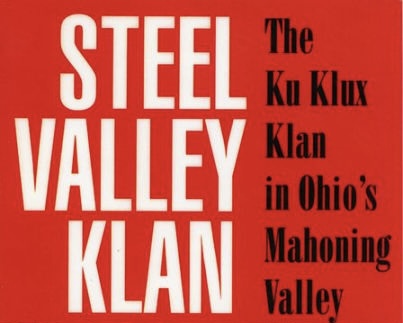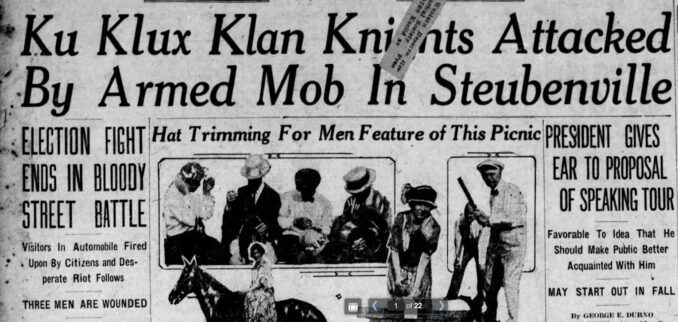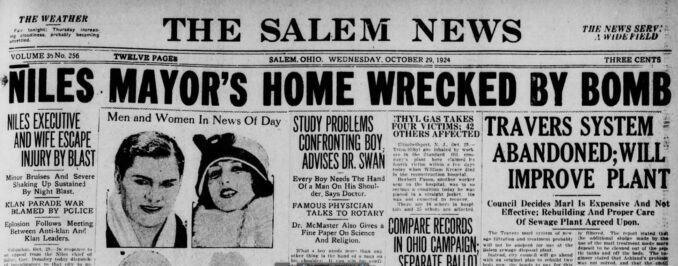Ohio 1924: How workers beat back the Ku Klux Klan
While growing up in Niles, Ohio — a suburb of Youngstown — my step-grandmother and other elders told me stories of the anti-Ku Klux Klan rebellions and the dramatic culminating battle on Nov. 1, 1924. It was a story she had heard throughout her childhood in her working-class, Catholic family.
I dedicate this article to her and to nurse Frances Dostal and steelworker Ted Dostal, who were founders of the Youngstown branch of Workers World Party in 1959.
The attacks on migrants in general during the national election and especially the Republican candidates’ vile lies about Haitian migrants in the southwestern Ohio community of Springfield, make this 100-year-old story of the 1924 immigrant-led rebellion in Niles that much more important.
On one side of the battle then was the working class of the Mahoning Valley of Ohio, which includes Niles. Most of the workers were newly settled Italian and Irish immigrants, and those who were religious were Catholic.
On the other side was the Ku Klux Klan organization, whose first growth had occurred in the South in the period following the Civil War as a racist and terrorist weapon against Black Reconstruction and freedom for the formerly enslaved African American population. While its core remained racist, the KKK’s second resurgence in the early 1900s was also directed against the wave of European immigrant workers of that period.
The Klan particularly focused its hatred on immigrants from countries that were predominantly Catholic — Ireland, Italy and elsewhere in southern and eastern Europe. In doing so, the KKK appealed to U.S.-born people who were Protestants and white for recruitment. Like the far right today, the Klan commonly used the chauvinist slogan, “America first!”
Workers World spoke with a current anti-racist activist from the Mahoning Valley whose Irish ancestors were among those who fought the Klan in Niles in 1924. She said: “The big lesson of the Niles Klan riots is that at any time, white supremacists can declare you to be part of the out group. No matter how white you think you are.”
She was pointing out that while today Irish and Italian Americans may believe themselves unlikely to be targets of the KKK or other fascists today as they were 100 years ago, it’s in their own interest as workers to stay in solidarity with those who are targets of racism and xenophobia. It’s a thought to keep in mind while reading of the anti-Klan battles of 1924.
Background of a major anti-fascist battle
The Klan made three public appearances in Niles in 1924, and each time the workers of the region met the KKK with fierce resistance.
Niles, the Youngstown area and the entire region known as the Mahoning Valley had attracted a major influx of Italian and Irish workers as well as Polish and Hungarian immigrants from the late 1800s through the early 1920s. Most were Catholic. Many were working in the brickyard plants, steel mills and glass factories in the region.
Youngstown State University professor William Jenkins tells the story in his book, “Steel Valley Klan: The Ku Klux Klan in Ohio’s Mahoning Valley.” “By 1924,” he wrote, “More than half of the Niles population was Irish and Italian, and they believed that the Klan threatened their way of life.” (Steel Valley Klan, Page 117) Despite this majority, Niles’ mayor at the time, Harvey Kistler, was a supporter of the Klan, and many of the town’s police were also members.

Part of book cover of book describing KKK riot and workers’ fightback in 1924.
The Klan’s anti-Catholic bigotry coincided with their racist and antisemitic beliefs designed to divide the working-class by nationality, race and religion. As quintessential fascists, the Klan embraced the most reactionary elements of finance capital — with a membership of many local and state police, company supervisors and small business owners, as well some backward laborers.
The Klan routinely sided with bosses against the unionization of workers, and their members often volunteered as strikebreakers (scabs) during labor disputes, including those in the brickyards, steel mills and glass factories of the Mahoning Valley. Klan leaders notoriously spread racist propaganda against workers’ rights using local newspapers. They used conservative Protestant churches as platforms.
Knights of the Flaming Circle
Prior to the November 1924 confrontation in Niles, there were many reported skirmishes between Klan bigots on one side and immigrant workers and their supporters on the other. These took place throughout the tri-state area of northeast Ohio, western Pennsylvania and the northern panhandle of West Virginia.

As early as August 1923, workers fought back against the KKK.
There were anti-Klan rebellions during 1923 and 1924 in the region. One major clash occurred in the Ohio River community of Steubenville, Ohio, in August 1923. There, when the Klan gathered at a hotel, a crowd of anti-Klan protesters confronted them, and cars belonging to racist KKK members were flipped over. The Steubenville battle helped initiate an anti-racist, fight-back organization known as the “Knights of the Flaming Circle.”
The workers created the KOTFC as a militant response to Klan terrorism in the tri-state area. Not only did that organization mock the Klan’s name; they also countered the hate group by turning some of their own tactics against them.
Klan members were notorious for burning crosses in the front yards of Black, Jewish and Catholic families. To offset the white supremacists, KOTFC members would often burn round tires in the front of the homes of known Klan members. Burning round tires was a trademark in reference to their name.
The KOTFC played a major role in the early 1920s in most anti-Klan battles in the tri-state region. A major rebellion rocked the Klan in the Pittsburgh suburb of Carnegie, Pennsylvania, in 1923. In that state, union coal miners fought the Klan in Lilly in 1924.
A Boston Review article published on Oct. 23, 2018, points out in those early 1920s, in the Youngstown suburb of Canfield, Ohio, “the Knights of the Flaming Circle scattered roofing tacks on the road to flatten the Klansmen’s tires on the way to a parade.”
KOTFC members also referred to themselves as “Red Knights,” and newspapers often called them “Circlers.” While most of their members worked in heavy industry such as steel and coal mining, they offered membership to anyone who was “not a Protestant,” and most of their members were in Ohio, Pennsylvania and West Virginia. (New York Times, Sept. 7, 1923).
While Protestant workers were barred from membership from the KOTFC, there were progressive Protestant workers who opposed the Klan and sympathized with the organization.
Anti-Klan actions in Niles, Ohio
The first collision between the Klan and Italian and Irish workers in Niles in 1924 happened on May 9. On that spring day, the Klan marched through town and concluded by burning a cross in front of a local high school. Community members refused to be intimidated and took matters into their own hands.
As Jenkins writes: “The Klan had lit a cross in front of the school, which some of the observers charged and knocked down. As the Klan members sought to recover the cross, bystanders pelted them with stones and bricks; several shots were fired.” (Page 119)
Not everything went well for the anti-racists. Unfortunately, two of the anti-Klan demonstrators were kidnapped by the Klan, taken to a field, beaten and forced to kiss a U.S. flag.
Klan sympathizer Mayor Kistler instantly blamed Italian youth for the commotion and publicly made disparaging remarks about Italian residents. With approval from the mayor and the police, the Klan announced another march the following month, scheduled for June 21, 1924.
Tensions were high throughout the community. The first Klan march on May 9 had been spontaneous, catching workers by surprise. This time, since the date was public, the workers had an opportunity to organize ahead of time.
In “Steel Valley Klan,” Jenkins describes a confrontation starting on June 19, two days before the big event: “On Thursday a bomb thrown at a burning cross erected across the McKinley Memorial blew the cross apart.
“The day before the parade [June 20], a crowd estimated to be 150 strong tore down a banner hung across Main Street to welcome the Klan. As an estimated ten thousand Klan members poured into Niles the next day, roving crowds assaulted them with an assortment of bricks, glass, rocks and pipes hurled at suspected cars. Windshields were broken and American flags torn from their perches on Klan cars. One young man was dragged from his car and beaten unconscious.” (“Steel Valley Klan,” Page 120)
According to a 2017 Tribune Chronicle article, a new relationship between Italian and Irish residents in Niles was forged with the Black community in Youngstown in 1924, because there was a common interest in fighting the Klan. (Tribune Chronicle, Aug. 28, 2017) Many of the anti-Klan forces in Niles started organizing with the KOTFC following the second confrontation in June of 1924.
The final battle in Niles on Nov. 1
Things calmed down in Niles for a couple of months following the second battle. That quickly changed when in mid-October 1924 Mayor Kistler once again granted the Klan a permit to march through town. The new date was set for Nov. 1, and the permit inevitably angered people. Klan provocations united community members of different faiths and national backgrounds against the fascists.

When Mayor Harvey Kistler approved the KKK march in Niles, 1924, someone chose to take action.
Mayor Kistler’s support for the Klan earned him a lot of enemies. The mayor’s front porch blew up in the middle of the night, just a couple of days before the Klan was scheduled to march.
On the showdown day of Nov. 1, 1924, KOTFC activists and anti-Klan residents met up early in the morning. Armed with guns, knives and other weapons, they formed barricades around the entrances of Niles. There were rumors the white-hooded terrorists were planning on causing physical harm towards the nuns at the two local Catholic churches. KOTFC members operated as security to protect the Catholic churches.
One Catholic church held a huge religious mass as an expression of solidarity. As Jenkins describes, “Our Lady of Mount Carmel held a crowded 6:30 mass for 1,700 members of the Italian community. They were united in their support for one another and in their willingness to die while resisting the Klan. By mid-morning Circlers had positioned themselves at the blockade points.” (Page 130)
With the help of the locally organized KOTFC, the anti-Klan resisters were able to stop and check every car that tried to attend the march that day. Various interviews and reports indicate that a train carrying over 1,000 white-hooded Klan terrorists was turned away due to one of the KOTFC blockades.
The KOTFC pulled over nearly every car that tried to enter Niles that day. Jenkins details: “On Robbins Avenue, Circlers armed with guns and knives had begun to stop all automobiles. If Klan robes were found, they were seized and sometimes torn apart, sometimes mounted on a nearby pole or tree and sometimes taken to a nearby house. Beatings usually accompanied the search; the stronger the resistance, the more violent the beating. Klan members were told to turn their cars around and leave.” (SVK, Page 130)
The working-class resistance in Niles beat back the Klan locally. Using the National Guard, local and state governments declared “martial law” for 10 days afterward, and the far-right terrorists were ultimately defeated. The Klan recognized their downfall, and Kistler was unseated not long after. The Klan has not made a public appearance in Niles since.
Lessons for today
Today, the far right is spewing hateful and divisive rhetoric against immigrant families in Springfield, Ohio. The city has received a lot of attention following the 2024 presidential debates when former President Donald Trump spread racist lies regarding Haitian migrants. Media reports indicate that Trump’s big lie about Haitian migrants “eating cats and dogs” was based on debunked allegations of which a neo-Nazi group, Blood Tribe, has taken credit on social media.
Subsequently, Springfield businesses and schools have been reportedly forced to close due to racist threats against Haitians.
Far-right organizations, such as Blood Tribe, the Proud Boys and the Ku Klux Klan itself, are attempting to recruit in Springfield, using the same contentious and hate-fueled rhetoric the Klan used 100 years ago. Trump and his vice-presidential pick, Ohio Senator JD Vance, have been purposely repeating allegations against the Haitian community that they know are lies.
Material conditions are different today than they were in 1924. The Klan no longer bars Catholics from being members. Right-wing Catholics — particularly antisemitic “radical traditionalists” and supporters of “Opus Dei” — have a home within the New Right. Vance, MAGA strategist Steve Bannon and ultraright Heritage Foundation President Kevin Roberts are all leading figures of the New Right, and they also support Opus Dei.
There are many important lessons for leftists and anti-racists to learn by studying the battle in Niles, Ohio, a century ago. KOTFC was successful in its tactics and strategies, but it would have been even more effective had they organized along working-class lines rather than religious beliefs. The KOTFC made an error by excluding anti-Klan Protestants who may have been sympathetic. For example, Black Protestant churches in nearby Youngstown and Warren, Ohio, were also susceptible to Klan terror.
With community support and solidarity from workers and oppressed people in neighboring towns, the KOTFC was able to squash the Klan. The successful battles against the white-hooded terrorists are inspiring events that should be examined by anyone interested in combating far-right bigotry and xenophobia today.

